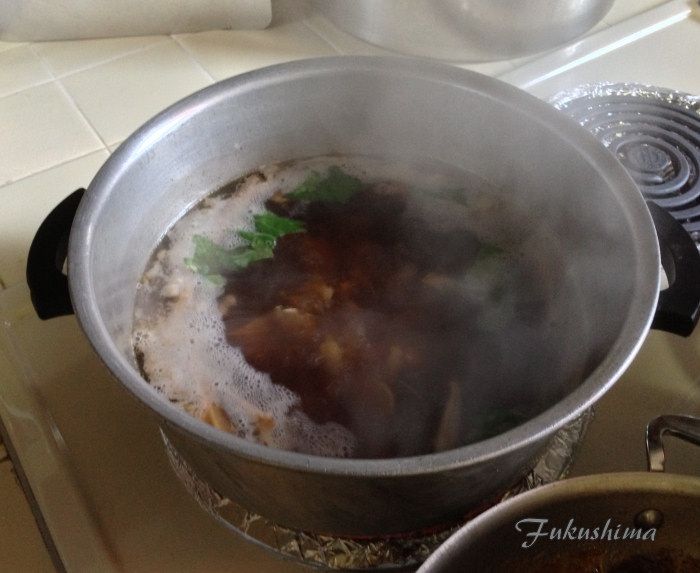Soba, a buckwheat noodle, has become familiar to many people in the United States as a cold noodle dish, often spice boldly and served dry. In Japan, the hot version is traditionally served at the end of the year, at midnight, with the cutting of the noodles as you eat them being symbolic of the severing of the old year and the beginning of the new year. There are many types of soba noodles, plain and flavored, and I have bought many of them, as I do not read Japanese and tend to buy what appeals to me. How this makes sense with dry noodles is unclear to me, but, there it is.
First off, is the broth, now, it is easy to go ahead and just use a product called Memmi, a pre-made soup base specifically for soba, but, since we have all the ingredients going already, we like to make out own. Actually, this year, I bought a fancy Memmi, and decided I would 'double' it with a few additions. So, into the pot went the original bottle of Memmi, along with 1 cups of water and 2 cups of dashi (bonito/konbu broth), 1/4 cup mushroom water, 1/8 cup shoyu, 3 shiitake, 1 bunch of Mitsuba, a few slices of ginger and a heavy splash of sake and 2 tablespoons sugar. This was all brought to a simmer and then turned off to cool.
Soba Stock
About the mushroom water, I like to use dried mushrooms to add depth to many dishes, I also believe the dried mushroom makes a superior pend product in braises and futomaki. Thus, I will soak a couple of packages of mushrooms in a quart of very hot water for an hour. This water is filled with flavor and finds it way into many dishes. Now, back to the soba. We simply boil up the soba per the unreadable directions on the package, taking care to guess when they are properly done. Soba cooks faster than wheat noodles, it also disintegrates faster than wheat noodles. But, we managed to get it right. Plating is as simple as placing a handful of warm noodles into a bowl, pouring some soba stock over it and sprinkling with fresh chopped green onions.
Midnight Soba
This is not your traditional lightly flavored soba, it has a bit more punch, and the stock ends up with more depth, to satisfy my desire for a complex flavor. It is a good way to end the old year.
And for the New Year, we have ozoni, a soup that has, over the years been something of a challenge for the non-Japanese folks that have joined our family. It turns out that mochi is not a universally loved texture amongst all cultures of this planet. I happen to love grilled mochi, which is the center piece of this dish. Oh well, here is the mochi all grilled up and ready to go.
See, little mochi, no big deal
The stock for this soup is actually built on a chicken broth, in the case of our modern take, we lace it with ginger, garlic, sliced shiitake and Mitsuba to develop flavor. Then the soup is seasoned through the use of sake, shoyu and dashi to add complexity. There are few flavors and even fewer times when a strong flavor is meant to dominate in these traditional dishes, in many cases, the variations of shoyu, sake, dashi and herbs is all that determines a good dish from a bad one. Once the broth is right, we added the Mizuna.
Organic Mizuna
Interestingly, this year, we found some organic Mizuna that looked fantastic, so leafy and fresh, we had to taste a bit to be sure it was the right stuff. It was, a bit of a spicy, definitely herbaceous herb, related to the mustard plant. We chopped the stems and added to the broth just moments before serving. This was a dish I hated as a child, wanting only to eat the grilled mochi, but, as an adult, it has become not only a delicious dish to be looked forward to, but a touchstone for me, hearkening back to times shared with people I have lost over the years. It is warming, delicious, comforting and bittersweet, the other four food groups I suppose.
To the lifeboats, oh nooo...
And into the bowls, the soup serves, with it's load of spring herbs to hearken to the New Year, it is symbolic of a new beginning. It is also symbolic of strength, much like the strength of herbs that fight through winter to bloom in Spring. We forgot to add the daikon, which is my fault, as I made the soup and don't like Daikon. Meh! In any event, there is our first two meals.
I would be lying if I didn't mention that I deep fried a couple of those mochi patties and ate them while ostensibly cleaning up the kitchen. Mmmm, nutty, crispy fried mochi with Satoshio.





I think I'll have to try making this ozoni some time. Where can I find the mochi? (Or did you make them from scratch too?)
ReplyDeleteSorry for my lack of attention. It was made from scratch as well. Just a lot of kneading of fresh cooked sweet rice. Although you can use rice flour as well.
ReplyDeleteWow. That must have been a LOT of kneading. Sweet rice is ridiculously sticky.
ReplyDelete